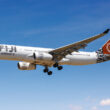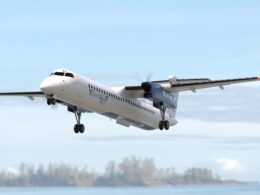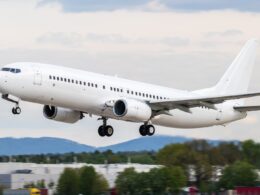Despite a round of positive news over the course of the past few months, including the beginning of the vaccination campaign, the reality has slowly crept back in as cases of COVID-19 surged across Europe. If in February 2021 the daily infection number dropped to its lowest point since October 2020, by mid-March, cases once again began to rise, pointing to a potential third wave.
The resurgence in infections is coming at a time when the travel industry was hoping to begin turning the corner on the disastrous business year in 2020. While many airlines have survived, that was done at a cost of very high debt levels across Europe. The debt will have to be repaid and if airlines cannot earn enough during the peak season of travel during the warm months, autumn might finally be the time when consolidation truly kicks off within the continent.
Short resurgence in travel
While 2020 was, no doubt, a very difficult year for the industry, European traffic levels did showcase a temporary recovery in the summer.
EUROCONTROL data showcases that between July 1 and mid-September 2020, the number of flights in Europe began to recover. On June 27, 2020, there were a total of 6,730 flights operated in the continent, a 79.4% decrease compared to the same day prior – five days later, the difference was 64.6%. The difference between the two corresponding periods shrank to as much as 48.7% in late-August 2020. However, the slight recovery was short-lived and as cases once again surged, travel once again began to slow down.
Capacity statistics from airlines also showcased that summer provided a short glimpse of hope. For example, easyJet operated 13,992, 30,849, and 21,692 flights over the course of July, August, and September 2020, respectively. According to the airline’s chief executive officer Johan Lundgren, easyJet restarted with a small-scale flying program on June 15, 2021, “with a disciplined focus on profitable, cash-generative flying,” he was quoted as saying in the airline’s FY2020 report.
Wizz Air, which continued to expand aggressively throughout the year with 14 new bases, as of January 2021, saw a similar rollercoaster ride in terms of passenger numbers throughout the three months. If in June 2020 the airline carried more than 960,000 passengers, a month later, the number rose to 3 million ‒ only 25.7% fewer than compared to July 2019. August 2020 was even a better month with 3.3 million travelers onboard the airline’s aircraft, indicating a 19.9% reduction in traffic compared to the same month in 2019.
Low-cost carriers were not the only ones to enjoy the glimpse of sunshine in the summer. For example, Lufthansa Group indicated that airlines within the group would utilize half of the group’s total fleet (380 aircraft) until October, which is 200 more aircraft than it did in June, per the company’s announcement in late-June 2020. International Airlines Group (IAG) (IAG), which has such brands as Aer Lingus, British Airways, Iberia, and others in its portfolio of airlines, Q3 2020 was by far the best quarter in terms of passenger numbers. During that quarter, IAG carried 6.5 million travelers, while in Q2 2020 the number was around 504,000, while in Q4 2020, 4.2 million passengers boarded aircraft that belonged to the Madrid, Spain-based airline group.
All in all, the “projections for this year and next are a little short of a disaster for European air transport. Border restrictions and quarantine measures have brought demand to a halt and the region has been affected even worse than most other parts of the world,” the International Air Transport Association (IATA)’s Regional Vice President for Europe Rafael Schvartzman described the year for the European aviation industry in December 2020.
A good summer is a must?
There is a good reason why Summer 2021 might become a make it or break it affair for many airlines in the continent. After it, the ever-looming predicted consolidation in the continent might finally become a reality.
Airlines, across Europe and the world, while have survived 2020, survival meant taking measures to ensure they have enough liquidity to see the light of the day in terms of the recovery in travel. The same easyJet increased its borrowing levels from £1.3 billion ($1.7 billion), as of September 30, 2019, to £2.7 billion ($3.7 billion) a year later. £987 million ($1.3 billion) of those borrowings have a due date before September 30, 2021. With net liquidity of over £3.1 billion ($4.2 billion), dedicating a third of that to only repay debts is not a very attractive proposition, especially if the recovery of travel will lag behind. The British low-cost was not the only airline with an increasing debt portfolio throughout the year, as Lufthansa Group (from €6.6 billion ($7.8 billion) to €9.9 billion ($11.7 billion), IAG (from €7.5 billion ($8.8 billion) to €9.7 billion ($11.4 billion), saw their debts soar by the end of their respective financial years.
While some fared better than others, the consensus was that raising debt was a must to weather the storm. Governments, to the annoyance of some (especially Ryanair), were particularly keen on supporting air connectivity throughout the most difficult crisis that aviation has experienced. Perhaps the fact that the Norwegian government provided aid, in the form of a government-backed loan in May 2020, to the already-struggling Norwegian Air was a good indication that lawmakers across the continent understood the devastation that the pandemic has brought upon aviation.
However, following a warning by the United Kingdom government’s Scientific Pandemic Influenza Group on Modelling advisors member Mike Tildesley that “international travel this summer is, for the average holidaymaker, sadly I think, extremely unlikely,” as he was quoted by the BBC on March 21, 2021. Following the statement by Tildesley, Airlines UK, a trade body for UK-based airlines, released a statement the same day that while it is too early to tell what the state of the pandemic will look like in the next 10 weeks, the “focus between now and then must be working with Ministers on a framework for travel that is robust and workable, and can stand the test of time as we enter the all-important summer period.”
“We do believe that by June, July, and August, there will be reasonably free movement of people within the UK and the European Union and vice-versa,” Michael O’Leary, the chief executive of Ryanair, told Sky News on March 24, 2021. “We should be calm, we should be reasonably confident and optimistic. I am not saying they are definitely going ahead, but I think there is a reasonable prospect that higher than 50%, that UK families will be holidaying,” across Europe, added O’Leary.
Profitable summer
Combined with the growth of debt across the industry, seasonality comes into play as well. For example, Ryanair earned around £180 million ($246 million), £350 million ($479 million), and £410 million ($562 million) of profit in June, July, and August 2019, respectively, as data by Apex by RDC Aviation pointed out. Furthermore, the data also showcased that the colder months of the year even brought losses to the low-cost carrier, as it lost money in four months that it had operated throughout 2019.
Fares go up considerably as well. For example, if an average two-way intra-Europe ticket from British Airways cost as much as around €140 ($165.5) in July and August 2019, the price goes went down to about €100 ($118) in December 2019. Lufthansa’s (LHAB) (LHA) fares showcased a similar trend in 2019: with the lowest average ticket price of around €80 ($94.6) in January, while the highest average price was in July 2019 (€140 ($165.5), according to data by Apex by RDC Aviation.
If the same scenario repeats once again, the looming debt repayments combined with a low season of revenue could result in a very difficult business environment, especially as debt is getting more expensive. Since travel is lagging in its recovery, credit ratings for airlines are downgraded and the number of potential collateral assets is dwindling. The danger is that if too much debt is taken up, the company could be spending its free cash on debt, rather than expansion, making the company a “zombie”, David Gard, a partner at Deloitte explained to Travel Weekly. “Airlines’ ability to access cheap debt has become more challenging because the community is becoming more risky,” Gard added.











